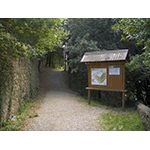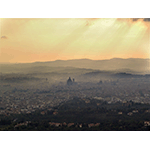Parco di Montececeri - Cave di Maiano [Montececeri Park - Maiano Quarries]
The quarries of Fiesole, and of Maiano in particular, exploited until the early 20th century, are famous for their sandstone, the so-called "pietra fiesolana", amply utilised by sculptors since the 15th century. Mentioned by Benvenuto Cellini and Giorgio Vasari, "pietra fiesolana" was most suitable for architectural works and monuments, as well as for more or less refined elements used for civil, religious and urban furnishings. It was so widely used that the Medicean government had to exert a severe policy of control over its exploitation. In the 17th and 18th centuries, in fact, the Fiesole quarries were "banned" and reserved exclusively to Florentine monuments. Among the last works built with "pietra fiesolana" are the columns in the courtyard, the stairway and other architectural elements of the Florence National Central Library. Today the area has become a park, along whose itineraries can be seen the basic features of the ancient quarries: the cut, the open-sky, and the stone quarry "cava ficcata", artificial caves supported by feet.
Montececeri is a "Leonardian place". In a clearing on the top of the hill, a stele bears the prophecy of flight from "Monte del Cigno" (Montececeri) noted by Leonardo on the inner cover of the "Codex on the Flight of Birds" now in the Royal Library of Turin.
Leonardo also mentions "Monte Ceceri" in drawing the contour of the hills around Florence on Folio 20v of tMadrid Ms. II.
In the vicinity of the Il Regresso curve, along the provincial road that links Fiesole to Florence, a plate on the wall of Villa La Torrossa recalls that Leonardo da Vinci decided to attempt human flight here, from Montececeri. Legend has it that Zoroastro da Peretola (the illegitimate son of one of the Rucellai, a pupil of Leonardo in Milan and in Florence, during the period of the wall painting depicting the Battle of Anghiari, who later died in Rome and is recalled as an esoteric personage) attempted to fly from Montececeri, ending in a disastrous fall.
Maiano is also linked to the figure of Temple Leader, the Englishman who rebuilt the castle of Vincigliata in the 19th century.
****************************
Texts by Anna Toscano, Graziano Magrini
English translation by Catherine Frost
Last update 03/gen/2008





